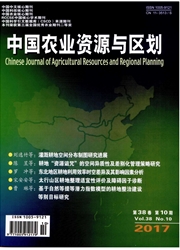

 中文摘要:
中文摘要:
农作物空间格局及其时空动态变化研究具有重要的理论和实际意义,已经成为地理学和生态学的前沿和热点研究问题。该文从农作物空间格局变化的特征、机理机制和模拟模型等3个方面系统总结了国内外最新研究进展,讨论了研究中存在的关键问题,并对未来发展趋势和重点进行了展望。研究认为,农作物空间格局变化特征研究主要包括基于统计数据的方法、基于遥感信息的方法和基于空间模型的方法。农作物空间格局变化机理研究主要围绕不同自然一社会经济驱动因子对农作物格局演变的作用机制开展,剖析农作物空间格局演变的内外部原因。农作物空间格局变化模拟模型从早期非空间模型发展到空间模型,而且越来较多模型对微观农户的作物选择或决策行为及其对农作物空间格局变化的影响给予了很多关注。在未来相当长的一段时间内,基于多尺度和多信息源数据融合的农作物空间格局变化特征提取、综合自然一社会经济多因素、宏观和微观多层次、静态和动态多机制的农作物空间格局变化机理分析、以及多学科和多方法综合的农作物空间格局变化模拟模型构建将是农作物空间格局变化研究的重点发展方向。
 英文摘要:
英文摘要:
Spatial patterns of crops and their dynamics have enormous consequences for both environmental sus- tainability and food security; It thus has been the important research topics of geography and ecology communities. This paper systematically summarized the current progress in crop pattern studies over the latest decade, specifically focusing on the spatial - temporal characteristics, driving mechanism and simulation models of crop pattern chan- ges. It found that the spatial- temporal change characteristics were studied by the methods such as statistical ap- proach, remote sensing, and spatial modeling techniques, while the driving mechanism was normally illuminated by a proper selection of regional - scale biophysical - socioeconomic variables and further attention was paid to the en- dogenous -exogenous factors that could potentially influence the stakeholders' decision on making a crop choice. Moreover, the simulation platforms were developing quickly and experiencing a transition from the traditional non - spatial expression of crop structure to the new spatially - explicit representation of crop allocation. This paper also i- dentified the key issues that were still relevant and tried to specify the future prospect and priorities in this field. It was believed that in a long - term, cross - scale and multi - source data coupling was the most trusted way for map- ping the spatial - temporal distribution of crop pattern ; proper selections on biophysical - socioeconomic variables, micro/macro perspective, and static/dynamic scheme will benefit the analysis on the driving mechanism of crop pattern current dynamics; interdisciplinary and multi -methods integration was the most effective approach to improve the understanding of crop pattern simulation.
 同期刊论文项目
同期刊论文项目
 同项目期刊论文
同项目期刊论文
 Proposing an interdisciplinary and cross-scale framework for global change and food security researc
Proposing an interdisciplinary and cross-scale framework for global change and food security researc Global-scale modelling of potential changes in terrestrial nitrogen cycle from a growing nitrogen de
Global-scale modelling of potential changes in terrestrial nitrogen cycle from a growing nitrogen de Simulated impact of elevated CO2, temperature and precipitation on winter wheat yield in North China
Simulated impact of elevated CO2, temperature and precipitation on winter wheat yield in North China Study on the feasibility and reasonability of the calculation methods of consolidating rural residen
Study on the feasibility and reasonability of the calculation methods of consolidating rural residen Retrieval of land surface temperature and emissivity from ASTER1B data using a dynamic learning neur
Retrieval of land surface temperature and emissivity from ASTER1B data using a dynamic learning neur 期刊信息
期刊信息
